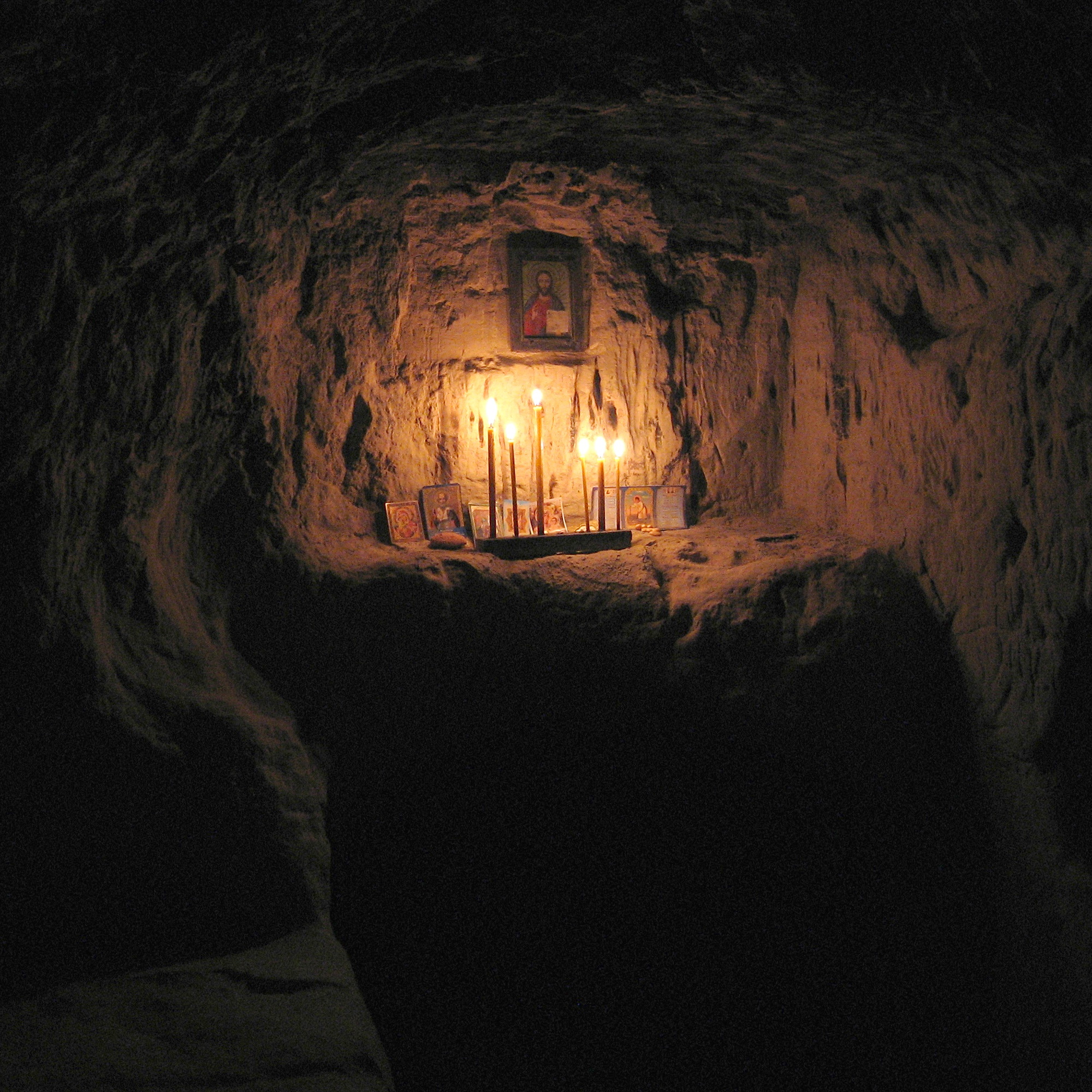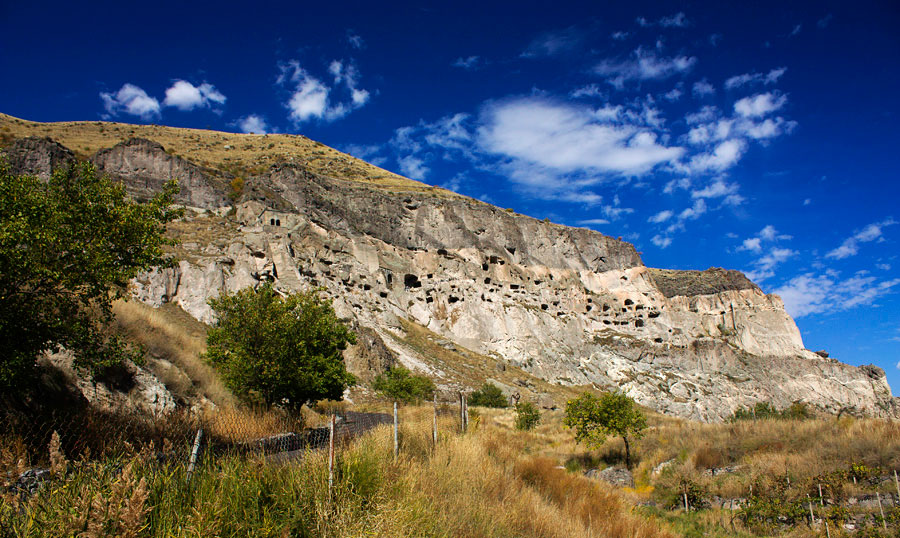|
Vanis Kvabebi
Vanis Kvabebi ( ka, ვანის ქვაბები; en, Vani's Caves) is a cave monastery in Samtskhe-Javakheti region of Georgia near Aspindza town and the more famous cave city of Vardzia Vardzia ( ka, ვარძია ) is a cave monastery site in southern Georgia, excavated from the slopes of the Erusheti Mountain on the left bank of the Kura River, thirty kilometres from Aspindza. The main period of construction was the sec .... The complex dates from 8th century and consists of a defensive wall built in 1204 and a maze of tunnels running on several levels in the side of the mountain. There are also two churches in the complex. A newer stone church that is in quite good shape stands near the top of the wall, and a smaller, domed church that clings to the rock on the level of the highest tunnels See also * Culture of Georgia * Vardzia cave city {{Georgian Churches Georgian Orthodox monasteries Caves of Georgia (country) Buildings and structures in S ... [...More Info...] [...Related Items...] OR: [Wikipedia] [Google] [Baidu] |
Cave Monastery
A cave monastery is a monastery built in caves, with possible outside facilities. The 3rd-century monk St. Antony the Great, known as the founder of monasticism Monasticism (from Ancient Greek , , from , , 'alone'), also referred to as monachism, or monkhood, is a religious way of life in which one renounces worldly pursuits to devote oneself fully to spiritual work. Monastic life plays an important role ..., lived in a cave. *Albania **Qafthanë Cave Church, cave church near Urakë **St. Mary's Church, Maligrad, St. Mary's Church, cave church in Maligrad, an island in the Prespa lake *Armenia **Geghard cave monastery/fortress *Bulgaria **Aladzha Monastery **Albotin Monastery ** Basarbovo Monastery **Rock-hewn Churches of Ivanovo **Cave monasteries of Krepcha **Monasteries of Provadia **Cave monasteries on the Plateau of Shumen **Cave monasteries of Tervel (town), Tervel *Ethiopia **Monolithic church *France **Abbey of Saint-Roman, Beaucaire, Gard, Beaucaire, Gard [...More Info...] [...Related Items...] OR: [Wikipedia] [Google] [Baidu] |
Georgia (country)
Georgia (, ; ) is a transcontinental country at the intersection of Eastern Europe and Western Asia. It is part of the Caucasus region, bounded by the Black Sea to the west, by Russia to the north and northeast, by Turkey to the southwest, by Armenia to the south, and by Azerbaijan to the southeast. The country covers an area of , and has a population of 3.7 million people. Tbilisi is its capital as well as its largest city, home to roughly a third of the Georgian population. During the classical era, several independent kingdoms became established in what is now Georgia, such as Colchis and Iberia. In the early 4th century, ethnic Georgians officially adopted Christianity, which contributed to the spiritual and political unification of the early Georgian states. In the Middle Ages, the unified Kingdom of Georgia emerged and reached its Golden Age during the reign of King David IV and Queen Tamar in the 12th and early 13th centuries. Thereafter, the kingdom decl ... [...More Info...] [...Related Items...] OR: [Wikipedia] [Google] [Baidu] |
Aspindza
Aspindza ( ka, ასპინძა) is a ''daba'' ("small town") in southern Georgia's region of Samtskhe-Javakheti with a population of 2,793 (2014 census), mostly ethnic Georgians. It is located at around . History The word "Aspindza" derives from a Persian word "اسب انداز", which means "a place to rest". The year of the foundation the town is considered to be 888, as Leonti Mroveli ( ka, ლეონტი მროველი) tells - By the end of the 16th century Aspindza had been conquered by the Ottoman Turks. According to their census, "Aspindza was a big village, that consisted of 50 families with gardens and orchards". The village is mentioned in chronicle of Sumbat Davitisdze ( ka, სუმბატ დავითის ძე) and Vakhushti ( ka, ვახუშტი). ჯიქია; გურჯისტანის ვილაიეთის დიდი დავთარი. წიგნი III. გამოკვლევა. თბილ� ... [...More Info...] [...Related Items...] OR: [Wikipedia] [Google] [Baidu] |
Vardzia
Vardzia ( ka, ვარძია ) is a cave monastery site in southern Georgia, excavated from the slopes of the Erusheti Mountain on the left bank of the Kura River, thirty kilometres from Aspindza. The main period of construction was the second half of the twelfth century. The caves stretch along the cliff for some five hundred meters and in up to nineteen tiers. The monastery was an important cultural center, a place of significant literary and artistic work. The Church of the Dormition, dating to the 1180s during the golden age of Tamar and Rustaveli, has an important series of wall paintings. The site was largely abandoned after the Ottoman takeover in the sixteenth century. Now part of a state heritage reserve, the extended area of Vardzia-Khertvisi has been submitted for future inscription on the UNESCO World Heritage List. History Soviet-era excavations have shown that the area of Vardzia was inhabited during the Bronze Age and indicated the reach of Trialeti cul ... [...More Info...] [...Related Items...] OR: [Wikipedia] [Google] [Baidu] |
Culture Of Georgia (country)
The culture of Georgia has evolved over the country's long history, providing it with a unique national identity and a strong literary tradition based on the Georgian language and alphabet. This strong sense of national identity has helped to preserve Georgian distinctiveness despite repeated periods of foreign occupation. Although Georgia is a largely traditional society, its culture continues to undergo changes in the 21st century. For example, Georgia is one of the first countries in the world to legalize cannabis for both recreational and medical use. Culture of Ancient and Old Georgia The Georgian alphabet is traditionally said to have been invented in the 3rd century BC and reformed by King Parnavaz I of Iberia in 284 BC. Most modern scholarship puts its origin date at some time in the 5th century AD, when the earliest examples can be found. Georgia's medieval culture was greatly influenced by Eastern Orthodox Christianity and the Georgian Orthodox and Apostolic Church, ... [...More Info...] [...Related Items...] OR: [Wikipedia] [Google] [Baidu] |
Georgian Orthodox Monasteries
Georgian may refer to: Common meanings * Anything related to, or originating from Georgia (country) **Georgians, an indigenous Caucasian ethnic group **Georgian language, a Kartvelian language spoken by Georgians **Georgian scripts, three scripts used to write the language **Georgian (Unicode block), a Unicode block containing the Mkhedruli and Asomtavruli scripts **Georgian cuisine, cooking styles and dishes with origins in the nation of Georgia and prepared by Georgian people around the world * Someone from Georgia (U.S. state) * Georgian era, a period of British history (1714–1837) **Georgian architecture, the set of architectural styles current between 1714 and 1837 Places *Georgian Bay, a bay of Lake Huron *Georgian Cliff, a cliff on Alexander Island, Antarctica Airlines *Georgian Airways, an airline based in Tbilisi, Georgia *Georgian International Airlines, an airline based in Tbilisi, Georgia *Air Georgian, an airline based in Ontario, Canada *Sky Georgia, an airlin ... [...More Info...] [...Related Items...] OR: [Wikipedia] [Google] [Baidu] |
Caves Of Georgia (country)
A cave or cavern is a natural void in the Earth#Surface, ground, specifically a space large enough for a human to enter. Caves often form by the weathering of rock and often extend deep underground. The word ''cave'' can refer to smaller openings such as sea caves, rock shelters, and grottos, that extend a relatively short distance into the rock and they are called ''exogene'' caves. Caves which extend further underground than the opening is wide are called ''endogene'' caves. Speleology is the science of exploration and study of all aspects of caves and the cave environment. Visiting or exploring caves for recreation may be called Caving, ''caving'', ''potholing'', or ''spelunking''. Formation types The formation and development of caves is known as ''speleogenesis''; it can occur over the course of millions of years. Caves can range widely in size, and are formed by various geological processes. These may involve a combination of chemical processes, erosion by water, tectonic ... [...More Info...] [...Related Items...] OR: [Wikipedia] [Google] [Baidu] |
Buildings And Structures In Samtskhe–Javakheti
A building, or edifice, is an enclosed structure with a roof and walls standing more or less permanently in one place, such as a house or factory (although there's also portable buildings). Buildings come in a variety of sizes, shapes, and functions, and have been adapted throughout history for a wide number of factors, from building materials available, to weather conditions, land prices, ground conditions, specific uses, prestige, and aesthetic reasons. To better understand the term ''building'' compare the list of nonbuilding structures. Buildings serve several societal needs – primarily as shelter from weather, security, living space, privacy, to store belongings, and to comfortably live and work. A building as a shelter represents a physical division of the human habitat (a place of comfort and safety) and the ''outside'' (a place that at times may be harsh and harmful). Ever since the first cave paintings, buildings have also become objects or canvasses of much artistic ... [...More Info...] [...Related Items...] OR: [Wikipedia] [Google] [Baidu] |


.jpg)

